The Variegated String of Pearls is noted for its pearl-like leaves that swirl in cream, green, and occasionally pink and purple colors when exposed to sun and water stress. Its stringy, slender stems drape gracefully and can drop several feet.
Its attractive design makes it a wonderful present for yourself, your loved ones, and anybody else on your list. It’s so vivid and eye-catching that some would argue it’s better than genuine pearls.
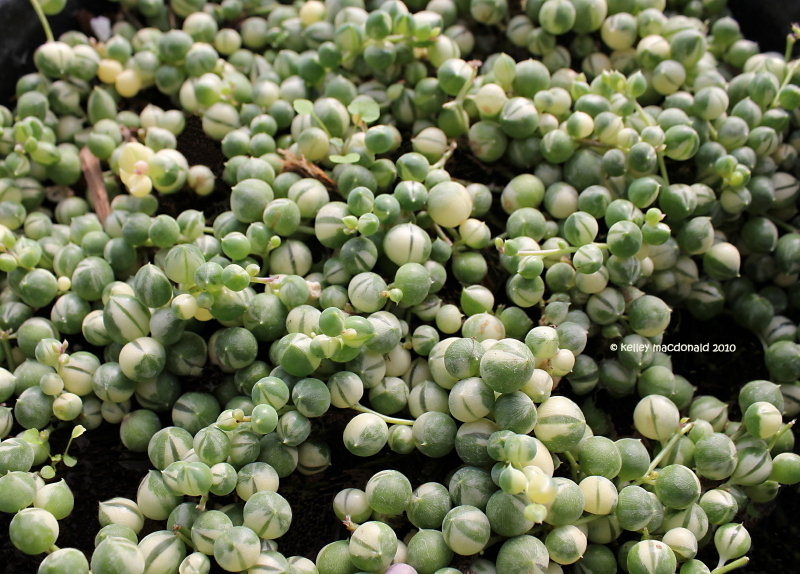
The Variegated String of Pearls is a popular item found on the wishlists of nearly all plant collectors.
The Variegated String of Pearls is a creeping succulent that can be easily planted on high shelves or pots that are hanging for a gorgeous look that is comparable to some other popular vining plants, such as the String of turtles, dolphins or hearts.
However, this is a succulent type that is unlike any other, as seen by its long and thin green stems, which support a cascade of pearl-shaped leaves that are green and white in color.
Known by its scientific name, Curio rowleyanus ‘Variegata,’ this gorgeous cascading plant will bring a touch of unexpected charm to any room. It can be planted both inside and outside, and it grows quickly, and propagates easily. However, the Variegated String Of Pearls Plant requires slightly more water than typical succulents. Moreover, it prefers full sun and cannot grow in alkaline soil.
Read on to learn about its propagation, care, and issues in more detail.
What Causes Variegation In String Of Pearls?
The cream or white color of the leaf is what makes the variegated String of pearls stand out from other varieties of String of pearls. This occurs due to the absence of chlorophyll in some cells, which ultimately gives the plant its characteristic color and pattern.
The loss of color is usually caused by a cell mutation at some point. When compared to the non-variegated variety, the absence of chlorophyll also causes the plant to grow more slowly.
However, the color is the only difference between the variegated and non-variegated variants of String of pearls. Other than that, both types are identical.
The String of Pearls (Regular Vs. Variegated)
Again, the leaves of the variegated String of pearls plant do not contain as much chlorophyll as the leaves of the non-variegated, or regular, String of pearls plant.
This causes the variegated plant to develop stripes of white in its leaves and grow more slowly than the regular String of pearls plant.
Many individuals include variegated String of Pearls plants, which are considered to be somewhat unusual, on the lists of their favorite succulents.
Variegated String Of Pearls | Quick Facts
String of beads or variegated String of pearls is a succulent plant with variegated leaves that look like beads.
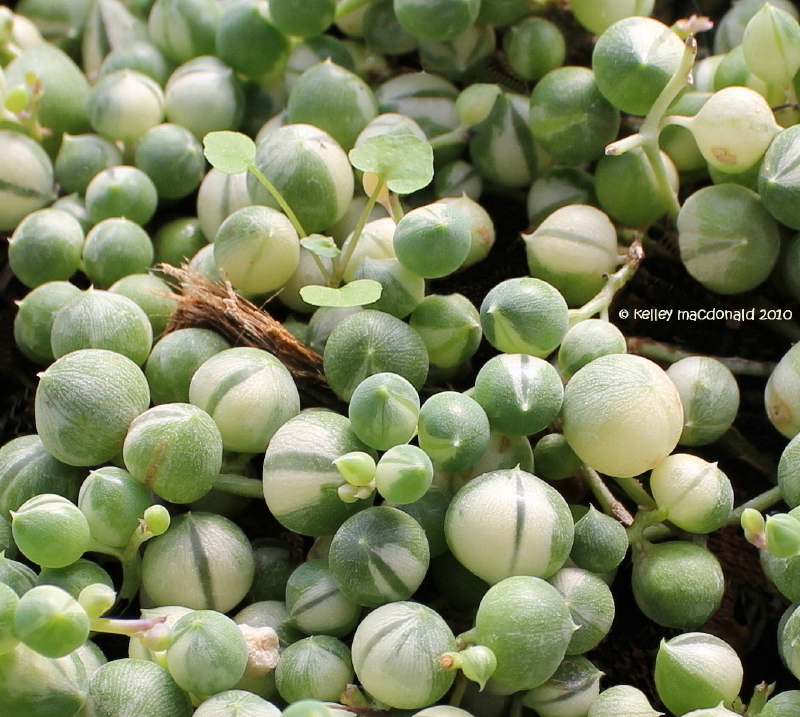
The Variegated String of Pearls makes a wonderful houseplant and is a true show-stopper thanks to the beauty and feel of its foliage that cascades downwards. You just need to make sure that you place it in a high place so that the stems can hang down.
However, it will also make a fantastic addition to outdoor settings if it is grown in pots and containers. In warm regions, it can even be grown on the floor and thrive when allowed to grow zigzag between other plants and fill up spaces between them.
However, if eaten, ‘String of Pearls’ succulents are hazardous to humans and animals.
Nevertheless, here are some quick facts about the Variegated String of Pearls plant that could help you decide whether or not this plant is a good choice for you!
| Other Monikers | The String of Beads, String of Pearls |
| Botanical Name | Curio rowleyanus ‘Variegata’ |
| Plan Family | Asteraceae |
| Type Of Plant | Perennial |
| USDA Growing Zones | 9, 10 and 11 |
| Difficulty To Grow | Easy to moderate |
| Growth Speed | Average |
| Methods Of Propagation | From stem cuttings with leaf nodes |
| Ideal Planting Locations | Windows that face south, west, or east |
| Ideal Soil Type | Sandy loam that has good drainage and is rich in organic matter |
| Ideal Potting Mix | Regular succulent or cacti soil mix with perlite or pumice supplementation |
| Ideal Soil pH | 7 to 7.5 |
| Sunlight Needs | 6 to 8 hours a day; Bright light, spanning from indirect to direct sunlight |
| Water Needs | Low; as a rule, once a week or once every two weeks is sufficient |
| Fertilizer Needs | Once every two to four weeks during the spring and the middle of the summer |
| Toxicity | Toxic for animals and humans |
Want More? Here. Are Some More Facts…
Flowers are uncommon in houseplants. However, provided there is sufficient water and light, the Variegated String Of Pearls Plant can bloom even indoors. The summertime is the best time to see the colorful String of pearls in full bloom.
It Smells Of Cinnamon!
The flowers have a tint that is between off-white and white, and they have long red stamens and vivid yellow anthers. The blossoms exude an aroma similar to cinnamon and will continue to bloom for almost 30 days. Moreover, the plant’s tendency to creep along the ground makes it an ideal candidate for growing in a hanging pot.
It Works Great With Windows!
You can achieve a stunning look by placing it on the shelf or the windowsill. However, to keep their foliage healthy, plants grown inside must receive some direct sunlight. Likewise, in the outdoor garden, you can cultivate this plant as a ground cover to keep weeds at bay. All in all, the plant can be grown successfully either indoors or outdoors.
It Needs Plenty Of Light!
However, in order for the plant to grow properly, it needs to be exposed to indirect light. Therefore, when cultivated inside, you need to make sure there is plenty of bright light.
Overall, this creeping succulent is a very popular choice for a houseplant due to its lovely white flowers and pea-like leaves that feature stunning variegation patterns.
It’s Easy To Grow!
Moreover, the fact that these plants store water in their leaves makes them very simple to cultivate. The plant can grow to its full potential with nothing more than bottom soaking alone. However, the plant must be grown in neutral to slightly acidic soil and must be exposed to full or partial sunlight to reach its full potential.
Growing A Variegated String Of Pearls Plant
A variegated string of pearls plant can be cultivated from stem cuttings or seeds.
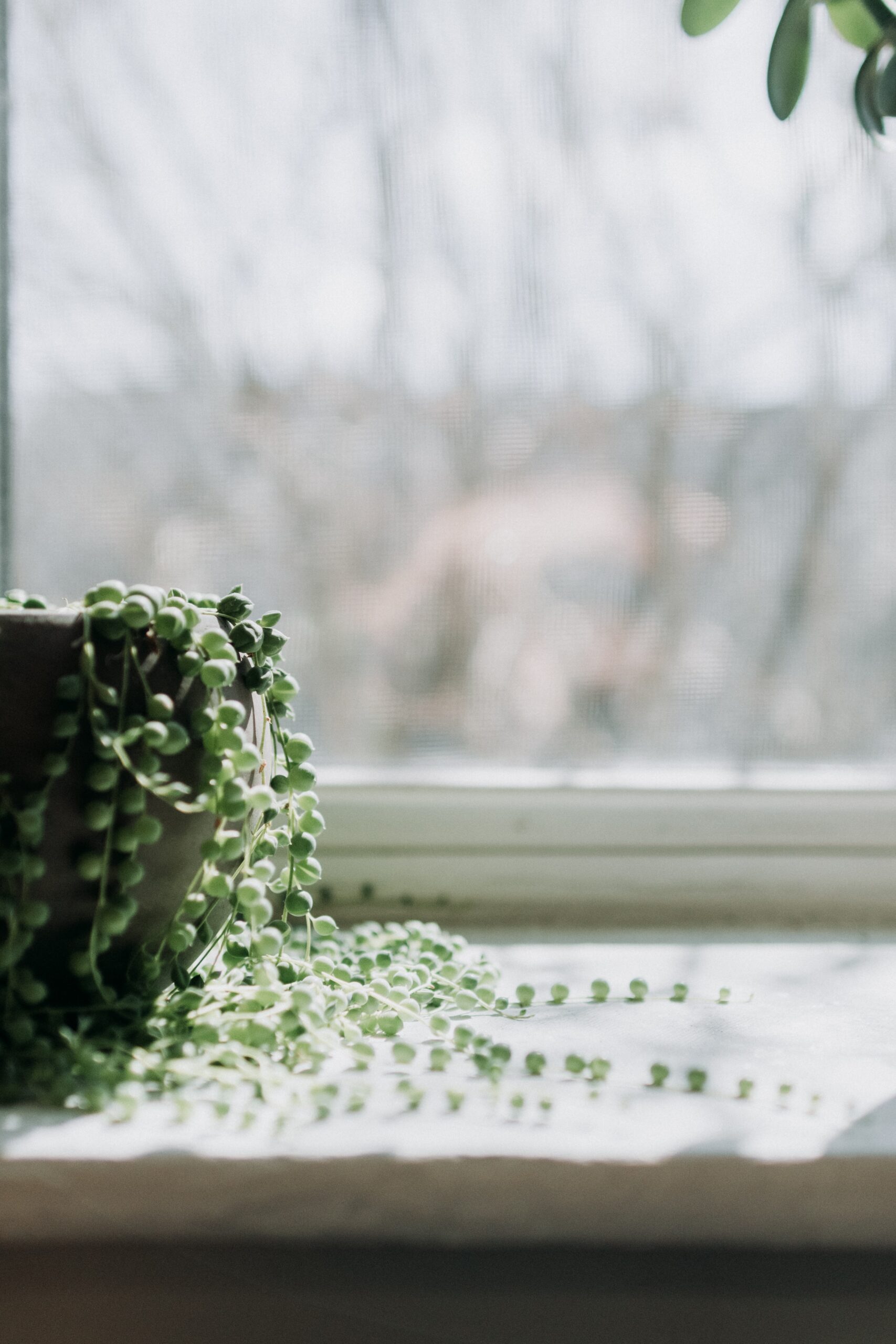
When grown outside, a String of Pearls creates an excellent ground cover and can also be used to create spirals from hanging pots. They do best in the United States Department Of Agriculture Zones 9 to 11.
We recommend planting them in locations that are exposed to indirect but bright sunlight for at least six to eight hours each day. Therefore, you should position the succulent in an area that receives partial to full sunlight.
It is possible to cultivate a variegated string of pearls either inside or outside, provided that the appropriate growing conditions are established in either location. You can cultivate them in a container with adequate drainage holes, such as a hanging basket or a pot.
You can grow a variegated string of pearls from seeds or stem cuttings. However, in order for the plant to grow from seeds, the soil must have the appropriate amount of moisture. Also, the germination process could take a few weeks, depending on the season.
It is not necessary to transplant the variegated String of Pearls plant. However, if you wish to, you may move it to a new container that has fresh soil in it.
When possible, transplanting should take place in the early summer or spring. Furthermore, it is essential to examine the roots to ensure that they are in good health before transplanting them.
Caring For Variegated String Of Pearls
The variegated String of pearls should be kept at 70 to 80 degrees Fahrenheit for the best results.
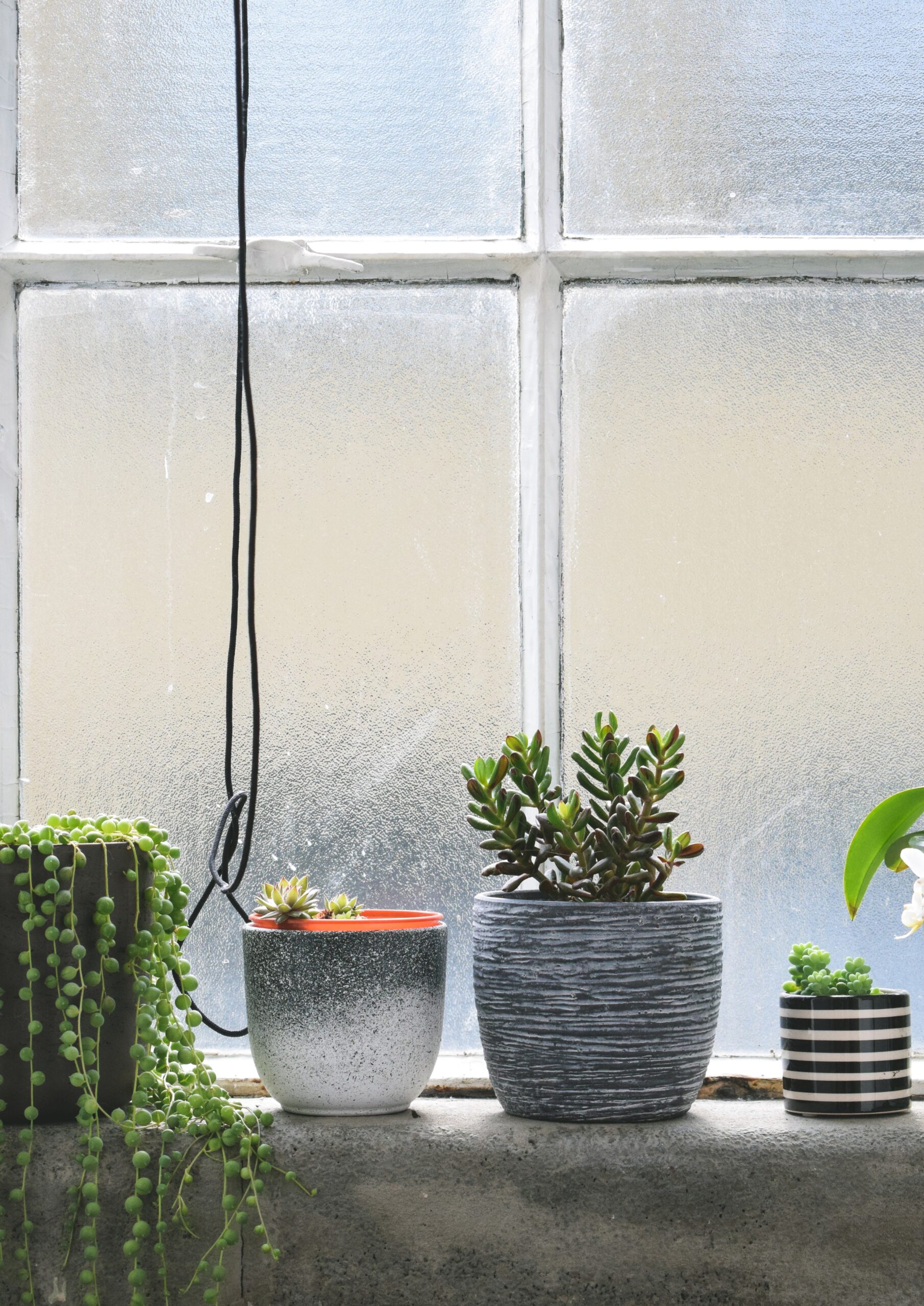
This creeping succulent has the potential to expand rapidly, given the right conditions.
It makes a wonderful houseplant and is a genuine attention-getter due to the interesting appearance and varied feel of the foliage. In general, they require very little attention as indoor houseplants, but they are also excellent succulents to grow outside.
They do best when grown in a container, hung in a basket, or spread out over the ground.
So, let’s go into the specifics of how to give these String of pearls succulent plants the best possible care. These plants need very little to almost no maintenance, and if they are taken care of properly, they can live for approximately five years.
Nevertheless, here is a detailed guide on how to care for these stunning plants:
1. Fertilization
In general, succulents don’t require a lot of fertilizer and giving Pearls Succulent too much fertilizer can also be fatal to the plant. However, in the spring and mid-summer, when these plants are growing actively, they may be fertilized once every two or four weeks.
There is no need to apply fertilizer in the fall or winter. In addition, the fertilizer should be diluted so as not to oversaturate the plant. There is also the option of using natural fertilizers.
For instance, adding used coffee grounds is an excellent approach to introducing organic material, improving the soil’s drainage, retaining water, and aeration.
However, because of the strong acidity of coffee grounds, you should avoid placing them directly on the soil. You can also utilize eggshells to supply much-needed calcium and potassium to the soil, which is beneficial to the plant roots.
2. Irrigation
It would help if you did not water a Variegated String of Pearls plant during its dormancy.
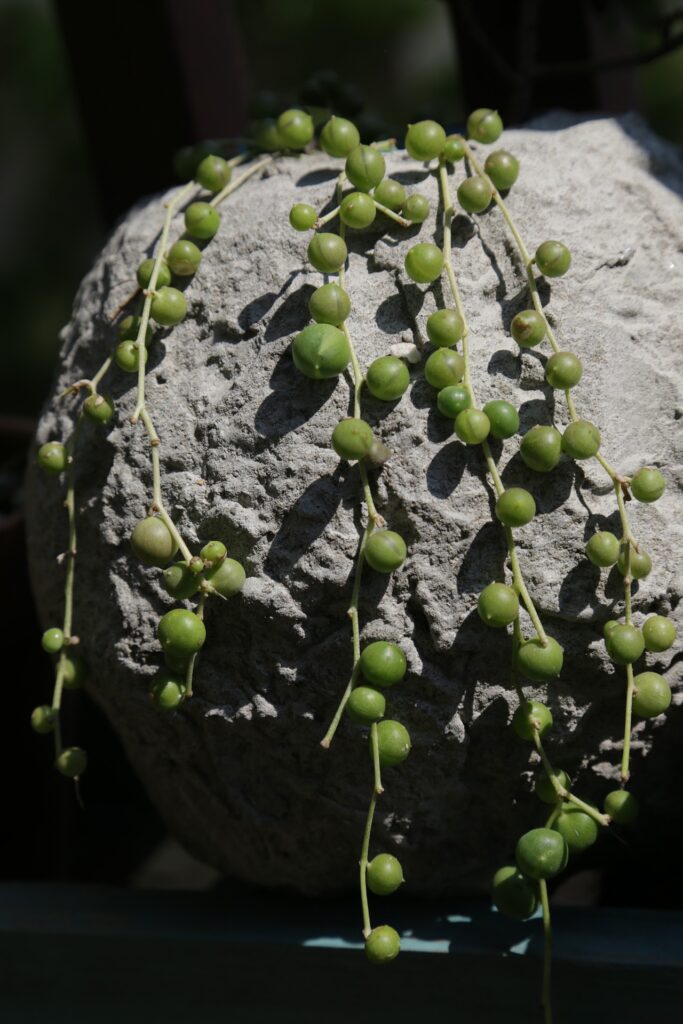
The String of Pearls are quite sensitive to being overwatered; thus, it is imperative that you provide them with the right amount of moisture.
In general, once every two weeks is the sweet spot for the best results. However, before giving your plant its next drink of water, it is a good idea to examine the soil to see if it has dried out to a depth of half an inch.
RELATED: Learn How to and When is the Best Time to Water Succulents
Reduce Watering In Winter!
Also, reduce the watering frequency in the winter months to once every month. A further word of caution regarding watering: resist the urge to use a mister or spray bottle when watering succulents. These tools can cause damage to these sensitive plants. How?
Overwatering Can Cause Root Rot!
Well, to begin, the succulent’s roots will not receive the necessary quantity of water that is necessary for them to become hydrated. Second, any water that pools and sits on the leaves for an extended period of time increases the risk of leaf rot disease and may even stimulate the presence of pests. Also, when you are irrigating “String of Pearls,” keep in mind that it remains dormant throughout the summer months.
Cut Back On Watering During Dormancy!
Therefore, throughout the summer, when your plant is dormant, you may need to cut back on how often and how often you water it. These plants will continue to grow throughout their dormant period, albeit at a much slower rate than usual. As a result, they will use considerably less moisture than they would during their active growing period.
The String of Pearls plants is best hydrated using the bottom watering method, as opposed to the top watering approach, which is one of the best ways to hydrate these plants.
Some Watering Techniques!
Bottom watering requires letting the bottom part of the plant sit in water for at least 50 minutes. The “soak and dry” method of watering is another option that you have.
It means delaying watering the plant until the soil is almost entirely dry, at which point it should receive an ample amount of liquid.
The best advice is to be strong and patient if you need to wait to water and to err on the side of caution rather than going all out with the watering can if you’re unsure.
3. Soil & Pot
It is crucial to have soil that has good drainage to foster the healthy growth of the plant and avoid root rot disease that is caused by damp soil. Furthermore, although the plant does best in sandy, loamy soil, a string of pearls can be grown successfully in many potting mixes for cacti. It is not difficult to create your own soil that drains efficiently.
Simply combine 75 percent perlite, sand, and grit, with 25 percent organic matter, like a high-quality compost that does not contain peat. Another crucial consideration for successful succulent cultivation is picking the right size container for the plant.
If the container is too large for the plant, the soil will remain wet for an excessively long period, which will cause the pearls resting on that wet soil to rot.
The pot needs to be large enough to let them fill to the full with water. Also, since String of Pearls has such thin roots, they do not require a particularly deep container either.
4. Humidity
The habitat in which the variegated String of pearls grows should have low humidity and be dry.

The String of Pearls is able to flourish in environments with a relatively low amount of humidity. In point of fact, dry air would not be harmful to this succulent because it is native to dry locations; hence, dry air would not be an issue for it.
It can thrive in practically any conventional humidity level for a domestic environment. However, if you reside in a region that has a climate that is quite dry, you should mist your plant somewhat regularly during the summer months.
5. Temperature
The plant does best in locations that have an average annual temperature of more than 60 degrees Celsius. The plant can also survive in temperatures ranging from 50 to 70 degrees F during the winter. However, if the temperature falls below 15 degrees F, the succulent will perish, so preventing that dip is of the utmost importance.
Also, avoid storing them in places where there is a draft, and an open window in winter since exposure to cold air may cause the leaves to fall off. Also, because String of pearls cannot tolerate the cold, you will need to bring them indoors during winter.
6. Sunlight
If you want to grow a Variegated String of Pearls indoors, you should do so in a room that gets a lot of natural light and is very bright.
It will also work if you grow it near a window that faces either the south or the west, as long as you keep the plant approximately five to ten inches away from the glass.
During the months when it is darker and cooler, you may want to consider moving them to a brighter place or placing them closer to a window to ensure that they receive the necessary amount of light each day.
The growth of the variegated String of pearls needs to be exposed to a combination of direct sunlight and bright indirect light for six to eight hours per day.
Plants grown outside benefit from being placed in full sunshine first thing in the morning and then moved to a location that receives dappled sunlight later in the day.
7. Pruning
It is possible that periodic pruning will be required as part of the care for a string of pearls, particularly if the pearls have become etiolated or leggy (often due to the lack of sun) and if the goal is to maintain their size or bring back their original vibrancy. However, pruning should only be done when absolutely essential to remove damaged, yellowing, or dead parts.
When doing so, you should always use cutters or a sharp knife. When you prune your String of pearls plants, you encourage new development, resulting in a fuller and bushier plant.
Common Issues With Variegated String Of Pearls
The String of Pearls requires little attention and is simple to care for. However, they are susceptible to pests and diseases that are also often seen in houseplants and succulents.
In the following paragraphs, we will discuss the most typical ones so that you can recognize and rectify these issues should they manifest themselves in your plants.
Aphids
Aphids are little, soft-bodied insects that feed on plant sap with the help of their piercing-sucking mouthparts.
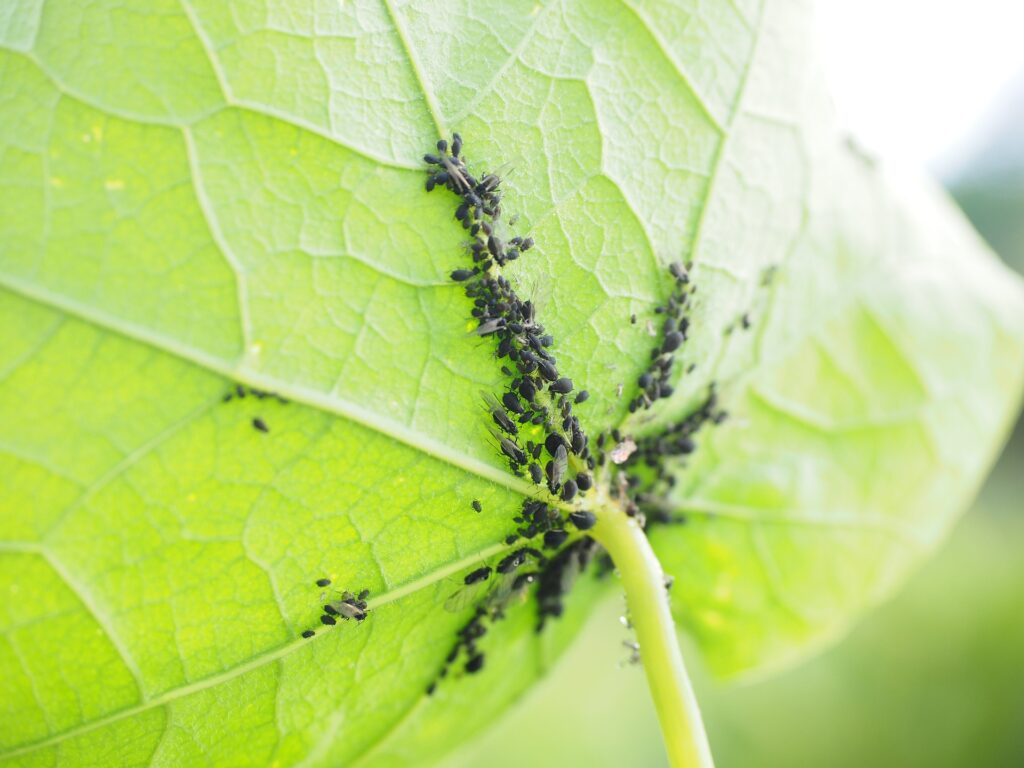
These nuisance insects, which are typically black, white, or green, breed in large groups, particularly on young vegetation, and are very slow to move.
Identical to mealybugs in appearance and habitat, these insects eat plant sap and make their homes in the crevices of branch joints and foliar nodes. However, there is no need to worry!
RELATED: Pests in Succulents How to Get Rid of Them for Good!
Using a cotton swab dipped in rubbing alcohol to treat large groups of these pests, followed by periodic spraying with detergent or household horticultural insect spray, is a practical, quick, very cheap, and affordable method for getting rid of them.
Mealybugs
Mealybugs are tiny, oval insects that are covered in white, cottony wax and move very slowly.
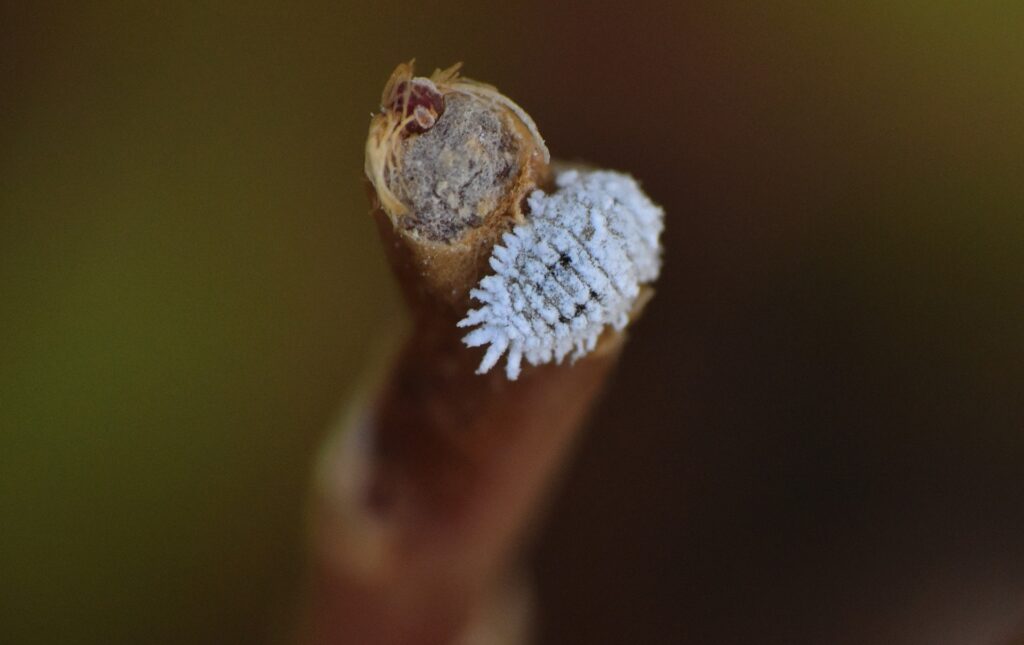
These are little insects that feast on the juices of plants, causing damage to the plants in the process. Mealybugs cause powdery white webs to form on the leaves.
They do this by secreting a sugary substance known as honeydew, which encourages the growth of mold. Because of this, the plant is more likely to become infected by bacteria.
Getting rid of mealybugs on your succulent can be done in a few different ways. To keep plants healthy, you may, for instance, sprinkle Neem oil on them once every one to two weeks.
Neem oil spray will aid in keeping mealybug infestations at bay. Additionally, remove any stems or leaves where mealybugs have established a home.
Overwatering & Underwatering
It is challenging to fix when a plant has been overwatered and may require repotting.
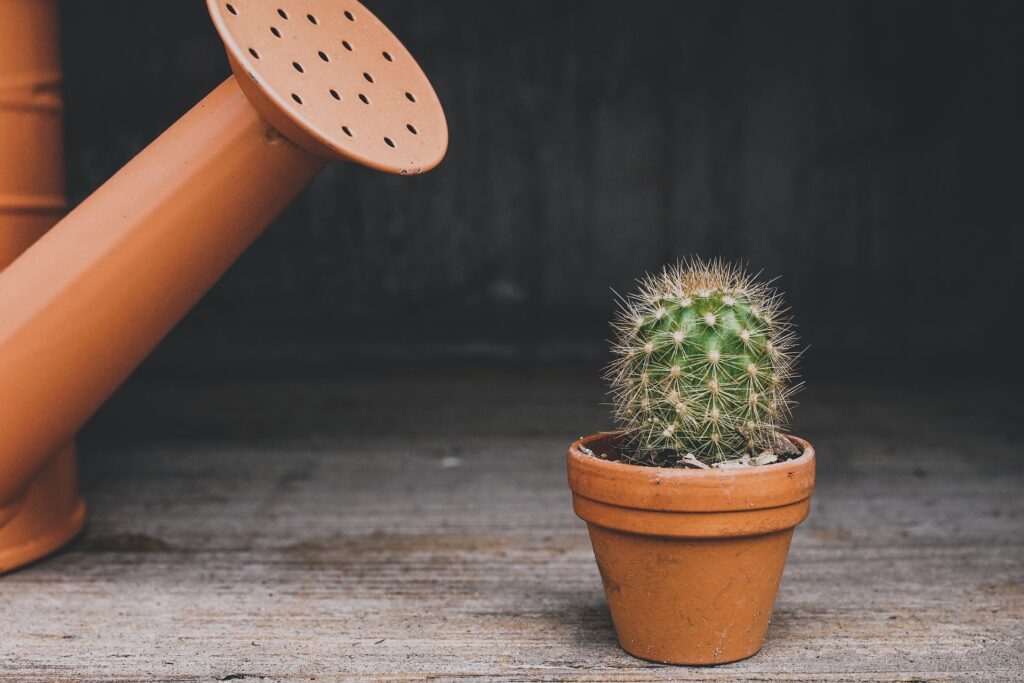
When the leaves are pale and the soil is wet, it is an indication that the plant has received an excessive amount of water. When a plant gets excessive moisture, the foliage color fades and may rupture, giving it a mushy appearance.
Drainage issues are to blame for this problem. When a plant has been overwatered, it is hard to fix and may require repotting. However, mealybugs are another potential culprit in the case of yellowing leaves.
If the plant is allowed to become underwatered, on the other hand, the foliage will become dried and withered. Simply ensuring that the plant receives the appropriate amount of water will quickly resolve this issue.
More water is needed for a String of pearls that are younger rather than older ones. So, ensure that you irrigate well, allowing the water to flow freely from the drainage spot in the bottom of the container as it drains.
Leggy Or Sparse Growth
If a plant grows leggy, it means it isn’t receiving sufficient light. Therefore, if you first see it, you should chop off that section to encourage new growth. This should be done as soon as possible. Moreover, you need to relocate it to a location where it will receive more light.
Overwatering also leads to stunted and slow development. So, adjust the amount of watering as necessary if you see patchy new growth.
Root Rot
Root rot is a problem that can affect many types of succulents, including the variegated ‘String of Pearls.
‘ This occurs when the roots are allowed to remain in the wet soil for an extended period of time. The leaves turning yellow or rotting, as well as the plant’s growth slowing down, are also very sure and very early signs of root rot.
If you observe either of these warning signs, you must take action immediately!
To avoid this problem, choose soil that drains well and water your plants appropriately. If the soil surrounding the plant is absolutely dry, then you should water the plant. In addition to that, take your plant out of its container.
Repot the plant after carefully brushing off any soil that may still be clinging to the roots, then remove and cut away any roots that have become rotten.
Propagating Variegated String Of Pearls
A propagation station or soil rooting can grow a “String of Pearls” from stem cuttings and seeds.
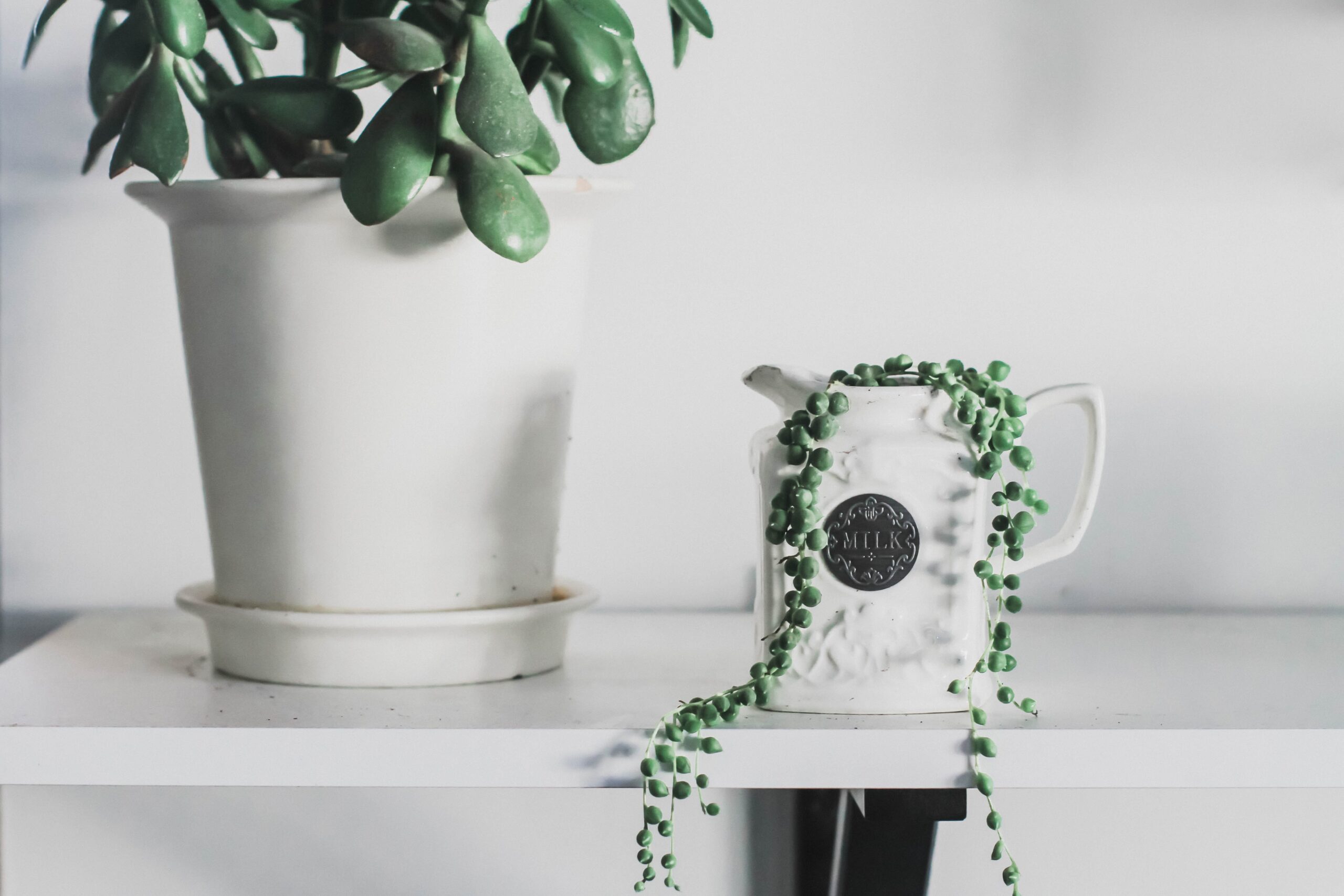
The String of Pearls is an easy plant to propagate since its roots are quite shallow, and it can readily form roots. So, using cuttings is the most straightforward approach to propagate it.
To begin the propagation process, all you need is a healthy cutting between three and four inches in length. After placing the cutting on the soil and applying a light amount of pressure, roots will begin to sprout out of the cutting.
Confused? Well, here is a detailed guide:
Step 1
Remove a stem that is at least 4 inches in length and cut it neatly and sharply.
Step 2
Choose a container for your soon-to-be-grown String of pearls, and then fill the container with potting soil that has a higher potential for drainage. In addition to this, check to see that the container has an adequate number of drainage holes.
Step 3
Put the cut section of the stem on a kitchen towel and leave it there for almost four to five days. This will allow the portion that was cut to dry out. Do not repot a fresh cutting; it is never a good idea to remove the stem immediately after cutting it.
Step 4
When the callus has formed, you may next position the cutting in a way that it is sitting on the surface of a very fine layer of soil, and then be patient and see the roots to begin to grow. When the first root forms, you can move on to the next step of planting.
Step 5
When the first roots grow, transplant the cutting into a container or pot filled with succulent or cactus soil. After carefully positioning the plant in the hole, pile some soil around the plant’s roots. It is essential that none of the plant’s leaves are buried in the ground.
Step 6
The next day, water sparingly and apply moderate pressure to the soil. These succulent plants do best in full sunlight in the morning and early afternoon but need to be moved into the shade during the warmest portion of the day.
Repotting Variegated String Of Pearls
Care must be taken when repotting strings of pearls because of their fragility and shallow root systems.
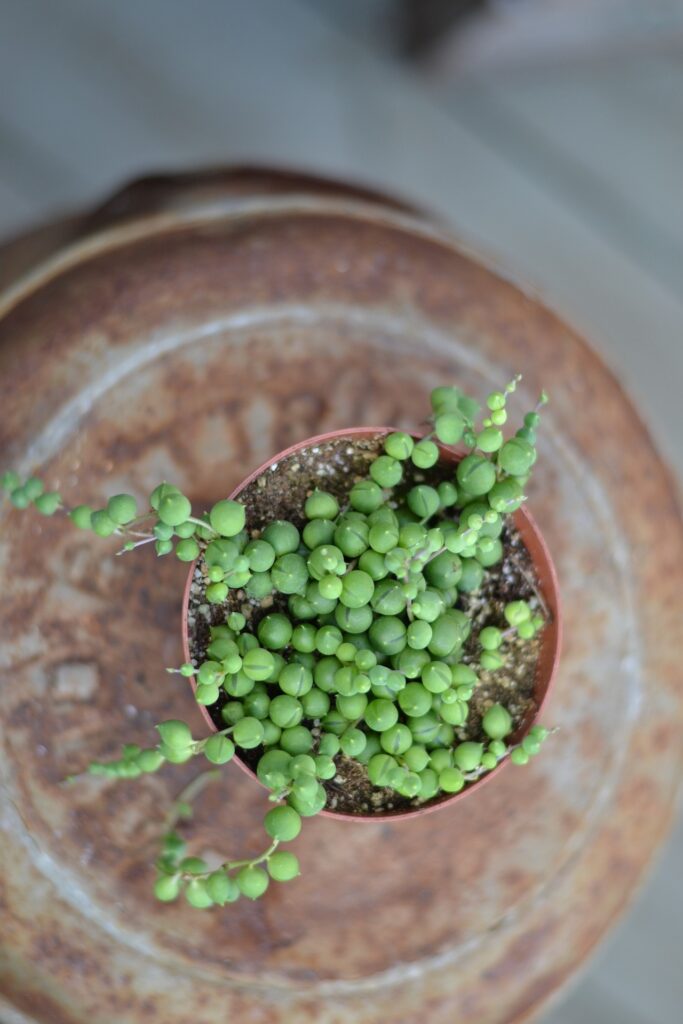
The ‘String of Pearls’ plant prefers not to be repotted too often. In fact, succulents, in general, flourish well when their roots are a little constrained. When the plant eventually outgrows its container, however, the variegated String of pearls can have their pots replaced with larger ones. The spring season is the best time to perform this task of repotting.
However, when you are repotting a plant, it is essential to check for any signs of rot in the roots. If you find any, remove them carefully by trimming the roots with a clean, sharp knife or pair of scissors that has been sterilized. Nonetheless, in the event that you need to repot these lovely succulents, the following is a step-by-step guide:
Step 1
Choose the pot you wish to use to repot the plant and make sure that it is at least two inches larger than the container it was previously housed in.
After that, you should fill the pot with good drainage soil.
Step 2
Bring or fold the trailing stems gently up to the top of the plant’s core and place them there. After that, rest one hand on the top of the plant, and rotate the container so that the plant can slip out of it. You can remove your String of Pearls from the pot in this manner without endangering any of the delicate beads on it.
Step 3
Make sure your new container is ready, and then set your plant inside. After that, replace part of the plant’s soil, ensuring to fill up any gaps.
You can now put your newly potted plant somewhere bright but out of direct sunlight. Also, ensure that the soil does not dry and is properly watered but not too much watered.
Making Variegated String Of Pearls Bloom
The String of Pearls plants produces teeny-tiny white blossoms that smell like cinnamon. To enhance flowering, reduce the amount of water you give the plant throughout the winter months and maintain a temperature of 60 degrees Fahrenheit inside the room where it is kept. This will help the plant produce spring flowers.
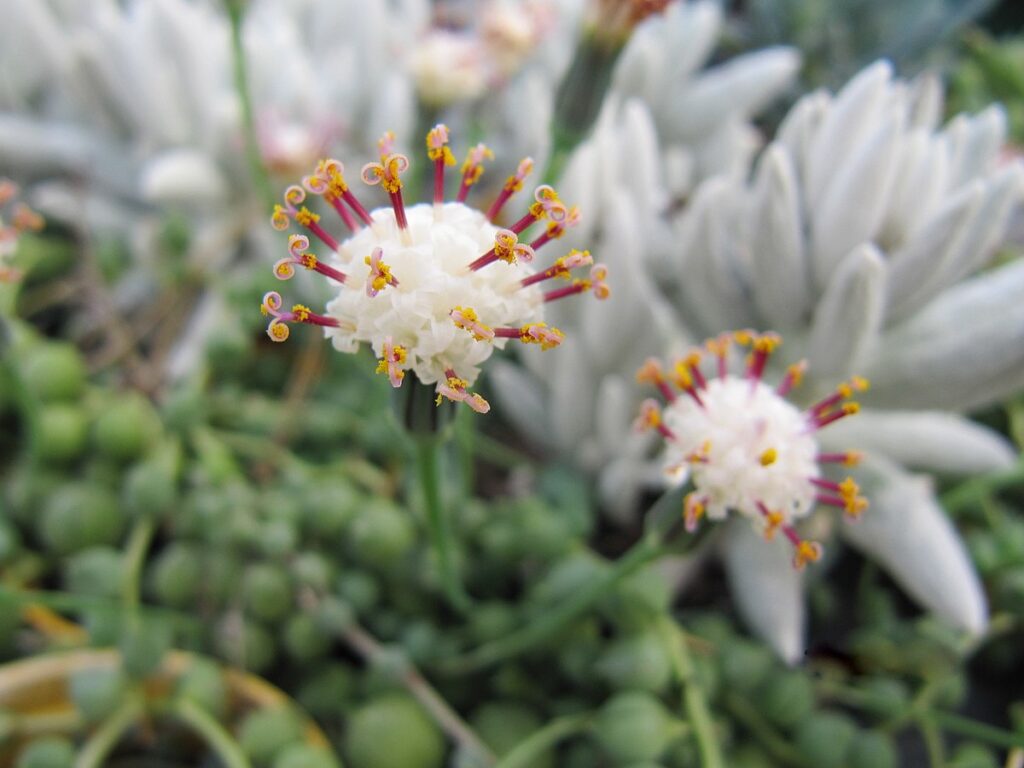
In the summer, look for blossoms that are practically off-white in color and have a brush-like quality to them. The stamens are long and crimson. Blooming in the summer is generally the result of conditions over the winter that are cool and dry.
The blooms will continue to bloom for roughly one month, but you should promptly remove any that have turned brown, yellow, or have died.
Final Thoughts
The care required for variegated String of Pearls is relatively low, making them an excellent choice for beginning gardeners interested in growing semi-succulent plants.
This trailing plant not only serves as an excellent option for home design, but it also has the ability to quickly brighten any room in which it is hung.
If you give the plant the attention it needs in terms of how much water you give it, how much sun it gets, and how well you manage the conditions of the soil, it will flourish and even reward you with lovely white blooms.
However, it would help if you were sure to place your String of Pearls in a location that is out of reach of both your children and your pets, and it is strongly recommended that you wear gloves whenever you handle it.
Frequently Asked Questions (FAQs)
Is a variegated string of pearls rare?
Senecio Rowleyanus Variegata, commonly known as the variegated String of pearls, is a highly coveted and unusual trailing beauty. It has pear-shaped leaves that are spotted with cream, green, and sometimes pink. All plant enthusiasts would love to have it on their Wishlist.
The plant thrives in a hanging basket and looks lovely whether it’s kept indoors in a bright, open room or outdoors on a sheltered patio.
How do you keep a variegated string of pearls alive?
The String of Pearls succulents requires a relatively warm environment, between 70 and 80 degrees Fahrenheit, to thrive. They adore water but can’t stand to spend too much time on soggy ground. Therefore, these plants really need good drainage. Also, if you must cultivate them indoors, a very well-lit and airy space with lots of windows is ideal.
How fast do variegated strings of pearls grow?
Depending on environmental factors, the String of pearls can increase in length by anywhere from 5 to 15 inches per year. Like the String of rubies succulent, the leaves grow on trailing stems that cascade over the sides of planters and hanging baskets. This fast-growing, trailing succulent is a fantastic houseplant and a true show-stopper if given the proper care.
Why is my variegated String of pearls turning pink?
The only time the leaves of any plant, including the String of pearl, change color is when the plant is under stress. This is because the String of pearls releases anthocyanin, a stress hormone. Unfortunately, this plant also cannot survive in extremely hot or cold conditions. Therefore, a string of pearls will deteriorate and lose color even if you expose it to cold winds.
How often should you water a variegated String of pearls?
You should only water a string of pearls if the soil at the plant’s roots is entirely dry. In general, once every two weeks is the sweet spot for these plants. Bottom watering, or leaving it in water for 45 minutes before taking it out, is recommended as well. Never top water. In addition, it needs to have some time between each watering.
Sources For Further Reading
String of Pearls. University of Wisconsin-Madison Division of Extension. (2022). Retrieved 28 October 2022, from https://hort.extension.wisc.edu/articles/string-of-pearls-senecio-rowleyanus/
Thank you for reading this article, here are some articles you might be interested too:
Learn Easy Ways on How to Take Care of Succulents
Find Out How to Choose the Right Succulent Pot (Easy Guide with Tips)







